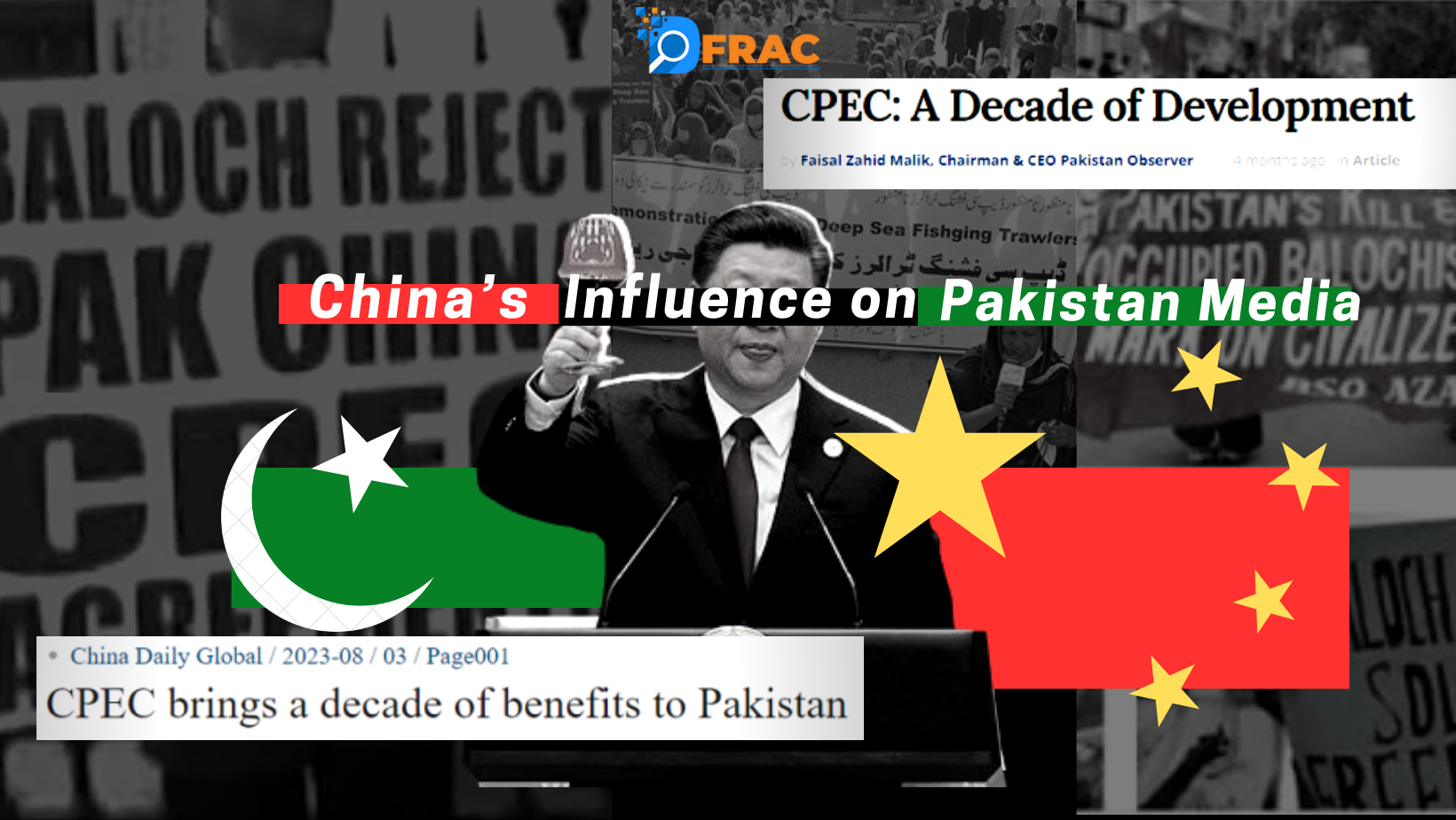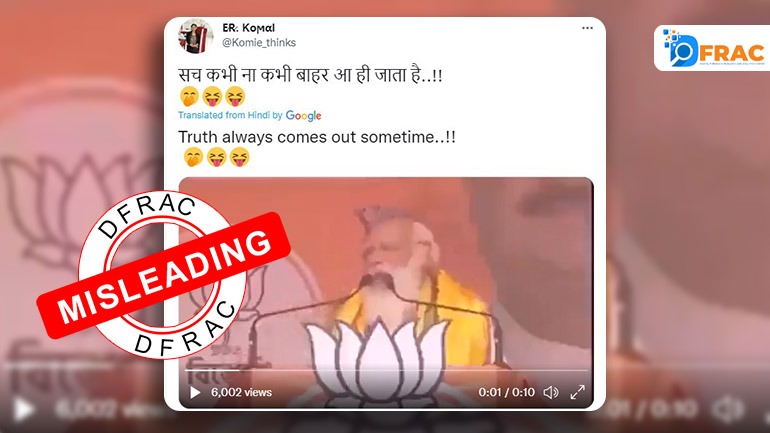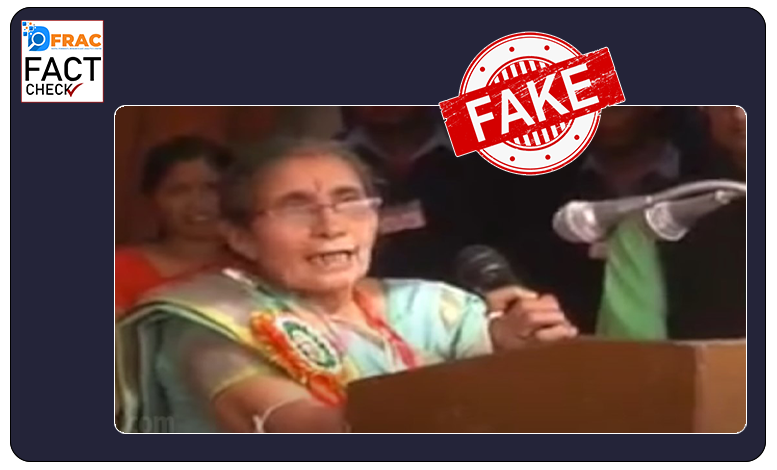Summary
This report examines the evolving dynamics of media collaboration and Coordinated Propaganda between China and Pakistan, focusing on CPEC. While the project has strengthened ties between Islamabad and Beijing, it has also generated backlash within Pakistan, particularly in local communities. Notably, concerns about negative media coverage have led China to take control of the narrative, influencing mainstream Pakistani media.
Our analysis will center on the following key aspects:
- China’s control over the narrative, influencing mainstream Pakistani media to avoid negative coverage
- Analyzes of media coverage on “10 years of CPEC” revealing a consistent positive narrative, overlooking the debt trap and Gwadar protests
- Discrepancy between Chinese-Pakistani media publishings and contrast perspectives from International outlets
- Investigation into protests against CPEC in Gwadar and Balochistan, with denials from Chinese authorities and skewed portrayal in local media.
- Case study on Chinese propagandist Makhdoom Babar highlighting China’s influence on shaping a pro-China stance among Pakistani journalists.
Introduction
Two key global events have shaped the current situation for China. Firstly, its mishandling of the coronavirus exposed vulnerabilities in crisis management, hindering its ambitions to be a global powerhouse. Secondly, China’s control over Pakistan faced scrutiny due to the perceived failure of CPEC, evident in reports of slow progress in the Belt and Road Initiative. In response to these challenges, China chose to proactively shape its narrative and take control of its own messaging.
Partnering With Struggling Pakistani Media Outlets
China’s major state-run media, referred to as the Big Four (Xinhua, China Daily, CRI, and CGTN), extended their reach to Pakistani audiences globally. Further, they introduced Urdu versions, aiming to better engage with Pakistan’s predominantly Urdu-speaking population.
In December 2019, Xinhua took a significant step by granting Pakistani news agencies and media organizations access to its news service content, encompassing text, photos, and videos in both English and Urdu. The agreement allowed these Pakistani media services to benefit from Xinhua’s news services without charge for the initial six months.

Launch of CPEC Media Forum and Rapid Response Information-Exchange Network
The annual CPEC Media Forum, established in November 2015, convenes political decision-makers and journalists from China and Pakistan to shape reporting directives on the CPEC and BRI. Noteworthy forums include the 2017 decision for direct reporting of CPEC projects to counter negative second-hand news.
Additionally, a Rapid Response Information-Exchange Network (RRIN) was initiated to counteract “fake news” about CPEC, managed jointly by China Economic Net and the Pakistan China Institute. This collaborative effort aims to construct factual narratives, combat negativity, and promote the profitability of the China-Pakistan bilateral alliance. However, it raises concerns about potential mainstream media uniformity in advancing BRI projects in Pakistan.
Analysis – a) 10 years of CPEC
We analyzed simultaneous articles from mainstream media in Pakistan and China on the completion of “10 years of CPEC” in June 2023, where a consistent narrative emerged.
Leading up to the scheduled celebration, articles highlighting the remarkable achievements of CPEC began to surface in both Pakistani and Chinese mainstream media. The coverage addressed the “no-debt” policy and acknowledged challenges and Pakistan’s difficulties in expediting projects while portraying China as a key driver in enhancing Pakistan’s economy. Notably, the narrative placed no blame on China in the context of the discussed issues.
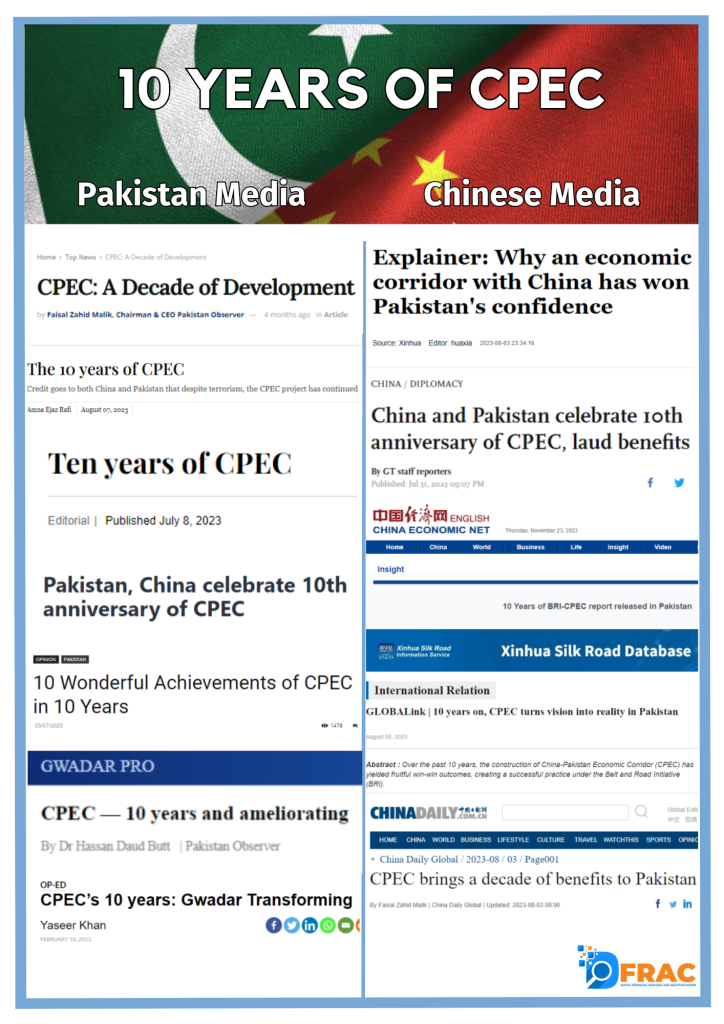
In an article written by the Express Tribune. pk, the writer addresses the “no-debt” policy by this statement – “Those critical of CPEC and equating it with debt trap need to focus on the following facts: The development of an area is for the betterment of the locals. CPEC is a gateway to international trade, as provinces and cities of Pakistan will be internationally connected, and the global outreach of people will be enhanced. This will open up prospects of education for students. Besides, the industrial linkage will usher in innovative trade practices. Sectors like agriculture will become much more advanced. Therefore, the approach to negatively propagate against CPEC is reflective of an adversarial mindset. This approach is a challenge for the South Asian region and adjoining countries like Central Asian states and Afghanistan which can benefit immensely from CPEC.”

Another article by Gwadar Pro (China sponsored media branch in Pakistan) mentioned the celebration as – “It has helped Pakistan develop its Blue Economy through Gwadar port and its connectivity with the hinterland through the western route and the rest of the world through the upcoming Gwadar airport which is being constructed with a Chinese grant of $230 million and will be completed in March this year.” The complete article missed the ‘Gwadar protest’ part whereas covered all the areas of glorifying the project.

An article by Daily Times.pk , also published about the Gwadar project where in a similar pattern to Gwadar pro and many other articles, the protests and challenges faced by the locals were missing.

The pattern followed by Pakistan media was from the Chinese media houses. They also covered the “10 years of CPEC” topic with the 3 major themes :
- CHANGING LANDSCAPE
- BACKBONE OF ECONOMIC DEVELOPMENT
- BENEFIT THE PEOPLE
These articles also omitted two significant topics: the debt trap and the Gwadar protests. China pursued a distinct strategy by publishing articles that provided explanations of CPEC’s achievements and benefits shortly after the celebratory event in June 2023.
Global Times had something more to tell besides the achievements of CPEC- “It is undeniable that the CPEC projects have brought concrete benefits to Pakistan, and both China and Pakistan will further improve the building of BRI projects despite external attempt to undermine it or some Western countries’ hyping of the “debt trap” rhetoric or security issues, analysts said.”

Pakistan Observer’s CEO, Faizad Zahid Malik, authored an article also published in China Daily. His focus in the article emphasized China’s vital assistance to Pakistan, highlighting how without Chinese support, Pakistan could have faced significant challenges.“ This is not the only time our neighbor has helped us in the past 10 years. It has bailed out Pakistan at critical junctures when the latter was in danger of becoming bankrupt. In addition, China recently provided a $2.3 billion loan for two years, providing Pakistan with much-needed breathing room in the face of decreasing foreign reserves.”

When we searched the same title on Google search, Pakistan Observer alone had 8 articles on its website.


Articles covered by International media on “10 years of CPEC”
While the global media covered the decade-long celebration of CPEC, they included essential facts, challenges, and economic aspects. These crucial elements were overlooked by both Pakistani and Chinese media in their coverage.
Nikkei Asia, a Japanese media house covered the ‘hype over China projects’. In the article, they interviewed a Karachi businessman- “Nearly a decade on, he expresses only disappointment in the roughly $50 billion undertaking known as the China-Pakistan Economic Corridor (CPEC). “I did not get any business out of CPEC because all the materials were bought from Chinese companies,” he complained.
“Many businesspeople Nikkei Asia spoke to echoed those sentiments. But while they have little good to say about the CPEC, Pakistan’s government has gone all out this month to celebrate the project’s 10th anniversary, hailing it as a triumph for the South Asian country.”

Despite China and Pakistan touting significant job creation numbers under the CPEC projects, Nikkei Asia’s article featured an interview with a local Pakistani expressing disappointment in the grand CPEC project.

In its analysis titled ‘Economists Tally Results of Decade of Chinese Investment in Pakistan,’ Voice of America delved into the economic aspects of CPEC. The interview with Haroon Sharif, the head of Pakistan’s Board of Investment in 2018-19, highlighted the need for third-party assessments to validate figures related to job creation under the CPEC.


An Australian media outlet, The Interpreter, delved into Pakistan’s economic struggles, specifically addressing the debt trap and financial strain caused by the China-Pakistan Economic Corridor (CPEC) investments.

The article highlights Pakistan’s persistent economic challenges despite investments from the China-Pakistan Economic Corridor (CPEC). Although Pakistan averted immediate default by securing a $3 billion deal with IMF, negotiations were tense and protracted. The nation grapples with an ongoing balance of payment crisis and diminishing foreign exchange reserves, indicating a fragile economic situation.
Similarly, South Asian Voices also published their findings on the persisting challenges, economic debacle, and protests surrounding China’s grand project.

We scrutinized job creation figures asserted by Pakistan and China. According to the Global Times, CPEC generated 236,000 jobs by 2022, with 155,000 Pakistani workers. However, contrary data reveals an increase in Pakistan’s unemployment rate. The accompanying graph illustrates a consistent upward trend in unemployment since 2015.
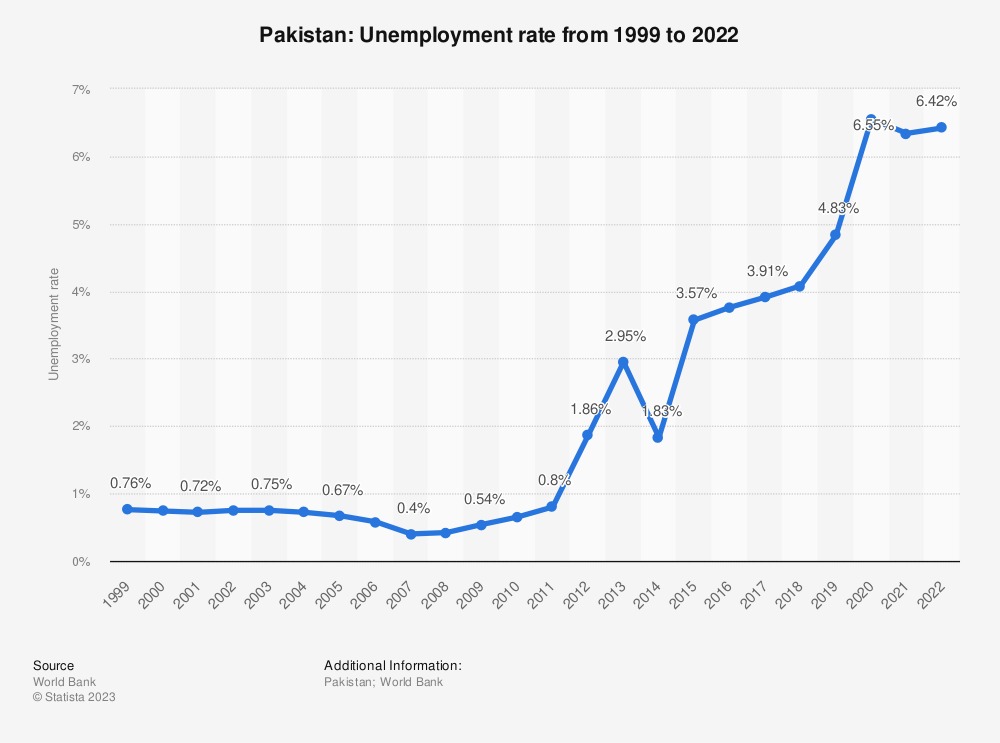
In addition to examining the celebrations and the parallel coverage by media houses in Pakistan and China, we also investigated the reporting of protests against the CPEC, consistently denied by China.
Analysis – b) CPEC Protests in Pakistan
Many times, Beijing and Islamabad signed agreements for CPEC projects in Balochistan without due consideration of the provincial government. As a result, the people of Balochistan are resisting CPEC, believing the projects would snatch away their freedoms. We conducted an analysis of protest coverage from 2021 to 2023.
Protests in 2021
In 2021, a Gwadar protest featured hundreds of fishermen, activists, and civil society members opposing the federal government’s issuance of fishing licenses to Chinese trawlers. Chinese media dismissed these allegations, labeling the news as ‘fake’ and attributing it to a ‘Western narrative against China.’
In a press briefing on November 30, 2021, the then spokesperson of the Foreign Ministry of China, Zhao Lijian, said some certain outlets, pointing out the Western outlets in particular, and others in general, were violating “basic journalist ethics and morality” with fake news regarding “fishing and docking” of Chinese trawlers in Gwadar port. He turned the Gwadar protest “out of the context of Gwadar port” stressing the importance of the port and calling it an “exemplary project” of China Pakistan Economic Corridor which would intensify the friendly relationship between the two countries.
His statement was covered by all major mainstream media houses of China like Global Times and CGTN.


Global Times’ articles, addressing Zhao Lijian’s dismissal of ‘fake news’ on Gwadar protests, were disseminated across various mainstream media outlets in Pakistan.

International media houses like Voice of America and The Guardian reported on the Gwadar protest against the CPEC, emphasizing issues such as the local shortage of drinking water and electricity. The protest news gained coverage from numerous media outlets worldwide as well.


Chinese media strongly rejected the coverage, categorizing it as ‘fake news.’ In a Global Times article, Yasir Habib Khan, a journalist from Gwadar Pro, asserted that the VOA report was baseless and inaccurate.
The article further stated Habib Khan’s statement – “China is our friend and we are not at all against China, China-led development, and the CPEC in Gwadar. The people involved in the Gwadar protest and sit-in are not averse to the Gwadar Port being operated by the Chinese company China Overseas Port Holding Company. Rather, they aim to seek the rights to live a life that every Pakistani deserves,’ the story said, quoting Maulana Hadayat ur Rehman, leader of the Gwadar sit-in protest.”
But on investigation we found the actual statement of Maulana Hadayat published in Baloch Times, on 6 Dec 2021 which was in contrast to the statement published in the Global Times article on 9 Dec 2021; quoted– [ Talking to WION, on phone call (November 22), Maulana Hidayat Ur Rehman told them that “Pakistan government is being hand-in-glove with the Chinese trawlers who are threatening their livelihood by illegally fishing in the southwestern Makran coast”.]

Similarly, China dismissed The Guardian reports as ‘fake news,’ aligning with the stance taken by Pakistani media outlets that published similar content.
The article stated-, “Reports by The Guardian and some other media outlets about protests against the China-proposed Belt and Road Initiative (BRI) in Gwadar, Pakistan, are untrue, and behind the fake news are some foreign media organizations’ deliberate smears of China-Pakistan cooperation, an investigation by the Global Times has found.”

Protests in 2022
Foreign Ministry Spokesperson Mao Ning’s Regular Press Conference on November 15, 2022- According to Pakistani media reports, there has been a huge protest going on in the port city of Gwadar for the last 20 days. The protesters threatened to block the China-Pakistan Economic Corridor if their demands were not met within a week. Is the Chinese government in communication with the Pakistani government in this regard as protests are threatening CPEC?
Mao Ning: These reports do not reflect the truth. The organizers have stated publicly that the protests are not directed at China or the China-Pakistan Economic Corridor (CPEC).

In 2022, we noted a higher volume of articles published in Pakistani media, surpassing those in China, aimed at challenging the narrative of ‘fake news against CPEC.’ This trend was also addressed in the CPEC media forum of 2022.

Protests in 2023
In 2023, a convoy of Chinese workers was ambushed by bombs and gunshots on their way from the airport to the Gwadar port at 9:17 am Sunday local time, according to a statement released by the Chinese Consulate General in Karachi.
While global media actively covered the Gwadar and Baloch protests against CPEC, China maintained consistent silence or denial, dismissing the news as fake. Additionally, China influenced Pakistani media to propagate the same narrative.

Global Times reported this about the attack on the Chinese Convoy – “Chinese observers criticized on Monday that it is a malicious smearing and a distortion of the facts that US media hyped the so-called local opposition sentiments against the China-Pakistan Economic Corridor (CPEC), a flagship project of the China-proposed Belt and Road Initiative (BRI), in their coverage of the Sunday terrorist attack on a convoy of Chinese engineers working on a project at Gwadar Port, and they noted that the terrorist militants’ extreme actions do not represent the will of local people.”
On a similar note, Associated Press of Pakistan published the news in November 2023.

Analyzing articles from 2021-2023, we observed that Pakistani coverage of the Gwadar protests focused on the events and demands but omitted China’s role. The articles emphasized protesters’ grievances with the Pakistani government, downplaying any anti-China sentiment. In 2021, an equal number of articles supported both narratives, but in subsequent years, Pakistan published more articles favoring the Chinese stance. This effort aimed to uphold China’s narrative not only within Pakistan but also on the global stage, shaping public perception in favor of the Chinese perspective.

Social media analysis of Pak-China CPEC narrative
In addition to articles, we examined social media hashtags expressing strong support for CPEC, particularly during protests in Gwadar and Balochistan. Notably, two hashtags, #CPECRevivesBalochistan, and #PakRiseswithCPEC, gained prominence during the inauguration of Gwadar Port’s Free Zone in 2018. Pakistani Twitter accounts actively utilized these hashtags, contributing to their increased visibility and promotion.

Within these hashtags, we identified several accounts employing a spam-like network strategy to consistently promote positive content about the project. The collage below illustrates accounts using the #PakRiseswithCPEC, showcasing their posts in a coordinated manner that aligns with a bot-like dissemination strategy.

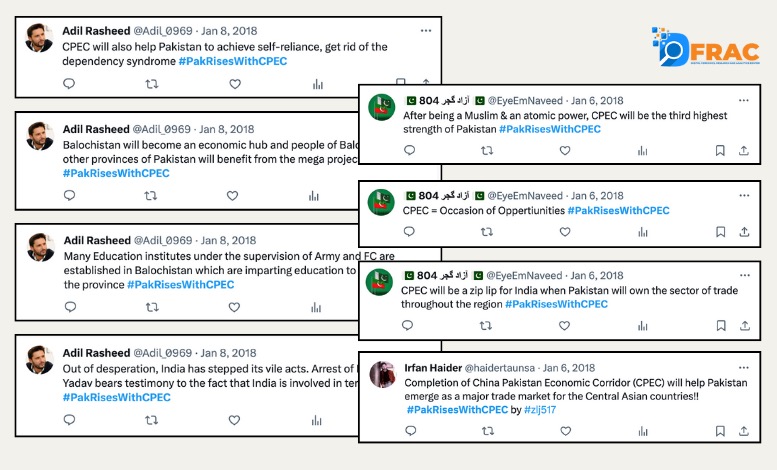
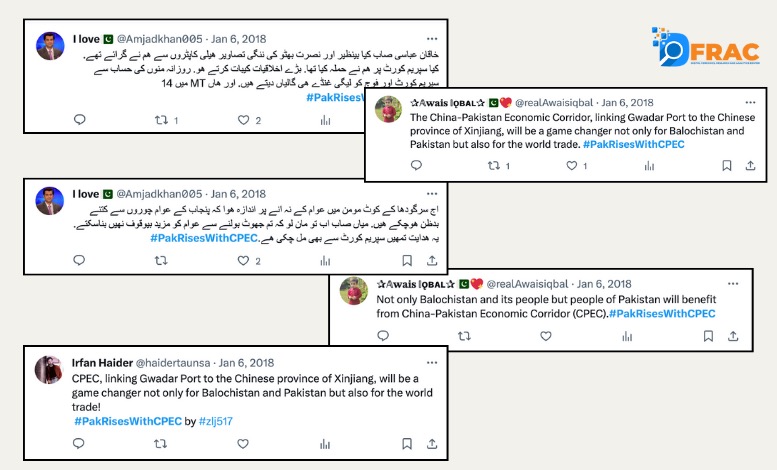
Case Study – Pak Journalist Pouring his love for China and Its Grand Project
During China’s celebration of the 10-year anniversary of the Belt and Road Initiative (BRI), Makhdoom Babar took on the role of a guest speaker on CGTN’s podcast. Focused on promoting the positive aspects of the China-Pakistan Economic Corridor (CPEC), he vehemently rejected Western media claims of a debt trap policy. Babar asserted that ongoing projects in Pakistan and Sri Lanka were counterexamples, dismissing the debt trap accusations as “baseless propagation” in the podcast.
About – Daily Mail
Makhdoom Babar serves as the Editorial Chief and President at Daily Mail News, Pakistan. While the website claims to be ‘Pakistan’s Leading English Newspaper,’ crucial details about its teams, events, and accomplishments are conspicuously absent. The website, oddly, doesn’t disclose its founding date, lacks advertisements—a primary revenue source for news platforms—and shows minimal evidence of physical newspaper distribution. This approach raises inquiries about the economic viability of the website.


In 2005, Makhdoom Babur actively collaborated with major Chinese media houses—China Daily, People’s Daily, and Beijing Review. This partnership involved the exchange of articles, news, and opinions, to be published on the Daily Mail website, signifying a strategic alliance.

Following this collaboration, he established the Pakistan-China Media Friendship Association in Beijing in 2005. In 2006, joint programs were organized in Beijing, Shanghai, and Islamabad to promote positive Pak-China relations.
In June 2015, Babur facilitated a delegation from China’s Yunnan Daily Press Group, signing an MoU to enhance understanding between the people and cultures of Yunnan province and Pakistan.



Coordinated Chinese Propaganda in Daily Mail’s Articles
The Daily Mail is a prominent advocate for China, dedicating a section to CPEC-BRI editorials that highlight positive aspects curated by its editorial team. This approach extends beyond CPEC, consistently portraying China favorably, even during challenging times like the COVID-19 pandemic. Notably, the website features collaborative videos with Chinese media houses, emphasizing a joint effort to showcase the positive aspects of the CPEC project.
Upon closer inspection, the website exhibits a notable focus on news related to China, often overshadowing coverage of its home country, raising questions about its editorial priorities and alignment with Chinese narratives.

The headlines in the Editorials section consistently emphasize China, covering topics from its challenges during the COVID-19 pandemic to presenting anti-US narratives and extensive coverage of CPEC projects. Makhdoom Babar, in particular, depicts China as the ‘stabilizer of the world,’ contributing to the prevailing positive narrative about China’s global leadership.
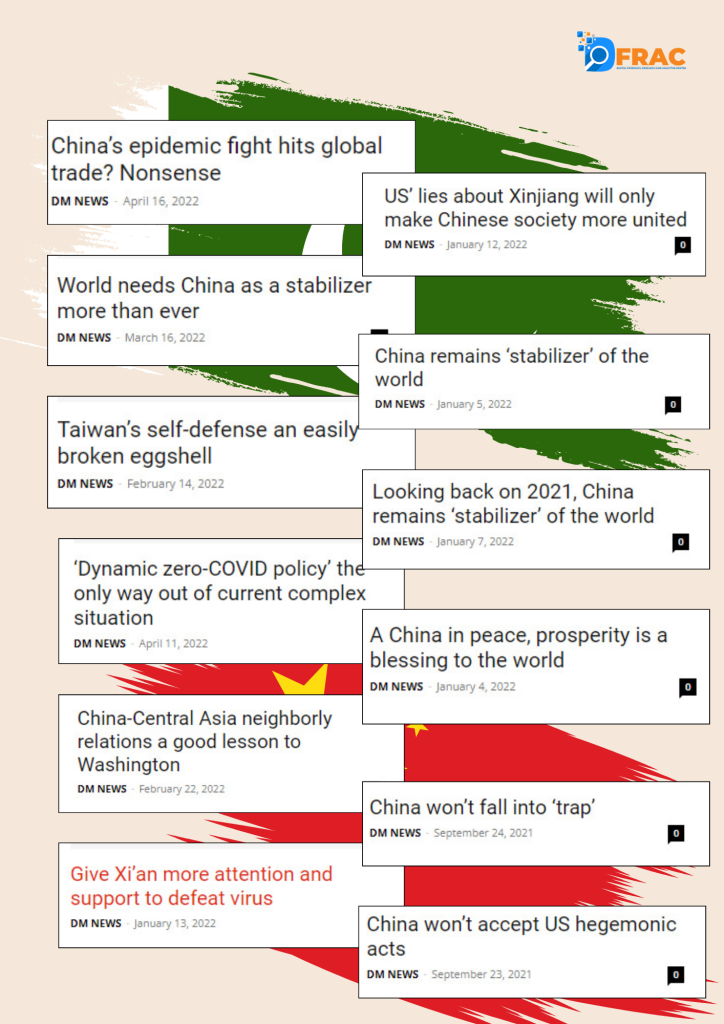
The common thread in these editorials is their unwavering admiration for China as an emerging global leader.
Additionally, the head of the Daily Mail showcased his support for China by producing a documentary titled “A Pledge of Iron Brothers,” released in 2019. The film aimed to highlight the robust bond between China and Pakistan, subtly serving as a propaganda tactic to portray a positive image of the CPEC projects.
In 2020, Makhdoom Babar released another documentary, “Saga of Iron Brothers.” Both documentaries received extensive coverage from major media houses in China and Pakistan, strategically targeting a broader audience in both nations.
Friendship Tales with Chinese Ambassador
Makhdoom Babar’s Twitter profile indicates a close connection with Chinese diplomat Zhao Lijian. Most of his retweets are from Zhao’s account and other Chinese sources, with a notable absence of retweets from his own media house. Strange!

Footprints on Chinese Soil
Makhdoom Babar consistently demonstrates an unwavering commitment to promoting the transformative impact of the China-Pakistan Economic Corridor (CPEC) on Pakistan’s development. His articles and viewpoints find publication in prominent Chinese media outlets such as Beijing Review, China Daily, and China-India Dialogue. In these platforms, he consistently echoes a familiar refrain, advocating for the virtues of China and reinforcing a narrative that aligns with a positive outlook on China’s initiatives.

Beijing Review alone has more than 10 articles where Makhdoom Babar has shared his opinions aligning with China’s media interests.

In 2020, Denmark’s Jyllands-Posten published a cartoon depicting the Chinese flag with virus-like figures replacing the symbolic yellow stars. In reaction to this, Makhdoom Babar released an image where the five stars on China’s national flag were transformed into thumbs-up symbols, accompanied by the message “Well done China, Keep it up.” China’s Global Times expressed significant appreciation for Babar’s gesture in response to the controversial cartoon.
Makhdoom Babar’s prominent presence in media conferences and frequent visits to China reflect his ongoing efforts to uphold Chinese influence in Pakistani media. During a visit to the Taihe Institute, a Beijing-based think tank, he shared insights into the news industry in China and Pakistan, with a focus on the complex dynamics of Pakistan-India relations. A notable photograph from the event featured his daughter, a Ph.D. research scholar at the Chinese University CUC, actively participating.

The 2023 Media & Think Tank Forum for SCO Countries witnessed a significant event on July 28 in Qingdao, China. Media outlets, including Pakistan’s Daily Mail, collectively signed the Framework Agreement on Strengthening Media Cooperation among SCO Countries, committing to uphold the Shanghai Spirit. Notably, Makhdoom Babar’s daughter played an active role in the signing ceremony, while he participated virtually in this noteworthy event.


Makhdoom Babar’s extensive involvement in Chinese media circles and forums underscores a strategic narrative-building approach by China. This strategy involves engaging journalists to align their interests with China’s agenda, often accompanied by acknowledgments and grants from the Chinese side.
Conclusion
The evolving dynamics in Pakistan media indicate a shift towards not just importing Chinese media services but also adopting Chinese perspectives on both global and domestic matters. It reveals China’s adept control over the narrative, orchestrating a positive portrayal in mainstream Pakistani media, notably during events like the “10 years of CPEC.” A systematic denial of protests against CPEC, showcasing a coordinated effort to influence both Chinese and Pakistani media can be observed.
The narrative crafted by China in Pakistan’s media unfolds as a complex tapestry, woven through collaborations, forums, and personal ties.


